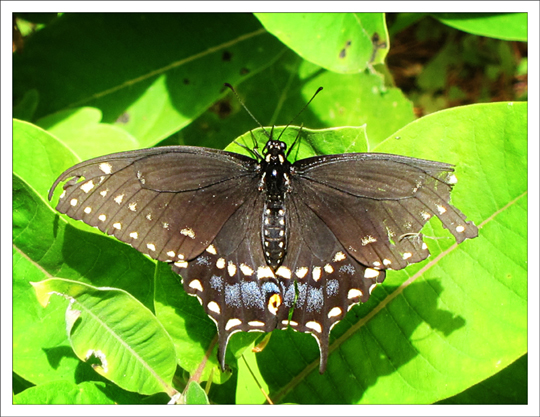Butterflies of the Adirondack Mountains:
Black Swallowtail (Papilio polyxenes)
 Butterflies of the Adirondacks: Black Swallowtail at the Paul Smiths VIC Butterfly House (4 August 2012)
Butterflies of the Adirondacks: Black Swallowtail at the Paul Smiths VIC Butterfly House (4 August 2012)
| This page is no longer being updated. For an updated version of this material, see: Black Swallowtail (Papilio polyxenes). |
The Black Swallowtail (Papilio polyxenes) is a relatively large butterfly that may be seen in the Adirondack Mountains in upstate New York during late summer. It is also known as the Eastern Black Swallowtail, the American Swallowtail, and the Parsnip Swallowtail. [1] [2] It is a member of the family Papilionidae (Swallowtails), named for the taillike projections on their hind wings, which resemble the tails of swallows. [3] [4] The Black Swallowtail is the state butterfly of Oklahoma. [5] The species name -- polyxenes -- is named after Polyxena, a character in the Homeric myth Iliad. [6]
The upper surface of the wings of the Black Swallowtail are black with a row of submarginal cream-yellow spots. [7] The Black Swallowtail has distinct orange eye-spots with a black spot in the center on the hind wings close to the tail.[8] Seen from above, the female has a row of yellow spots and an iridescent blue band, while the male has a yellow band near the edge of his wings. [9] [10] The abdomen has a longitudinal row of yellow spots. The average wing span is 3.2 inches. [11]
At low temperatures, Black Swallowtails perch close to the ground with their wings spread. At higher temperatures, they perch higher and fly more frequently. Courtship and mating occur from midday to late afternoon.[12]
The eggs are yellow. [13] The mature caterpillar is up to 2 inches long, sporting white to green with black bands dotted with orange or yellow spots on each segment. [14] [15] The larva of this insect feeds on many plants in the parsley family, including Queen Anne's Lace, carrot celery, and dill. [16] [17] [18] The adult feeds on nectar from flowers such as red clover, milkweed, and thistles.[19] [20] [21] The adults flutter their wings while taking nectar, possibly for balance. [22] [23] Black Swallowtails lives from six to fourteen days. [24]
 Butterflies of the Adirondacks: Female Black Swallowtail at the Paul Smiths VIC Butterfly House (1 September 2012)
Butterflies of the Adirondacks: Female Black Swallowtail at the Paul Smiths VIC Butterfly House (1 September 2012)
From an ecological standpoint, the Black Swallowtail is a generalist. [25] This butterfly occurs in most areas of the eastern US from sea level to the mountains. [26] [27] Its habitats include gardens, fields, suburbs, marshes, damp meadows, and roadsides. [28] [29] [30] It is seldom seen in forest interiors. [31] It has adapted well to suburban and urban environments.
Black Swallowtails reportedly have two or three broad, overlapping broods, from April to October in the North.[32] [33] The flight period of the Black Swallowtail in the New York City area of New York State is from mid-April to late September, but they are most commonly seen in that area in late May and mid-July. [34] The Black Swallowtail's flight period in the Adirondack Mountains has not been documented. However, they have been observed within the Adirondack Park as early as June. [35] During the summer of 2012, the Black Swallowtail was seen in the Paul Smiths VIC Native Species Butterfly House in early August and early September.[36]
References
- Susan Grimm Hanley. Interpretive Naturalist, Paul Smith's College Native Species Butterfly House. Species Logbooks.
- Butterflies and Moths of North American. Species Profiles. Confirmed sightings: 8/4/12; 9/1/12
- Government of Canada. Canadian Biodiversity Information Facility. SpeciesBank.
- Massachusetts Butterfly Club. Massachusetts Butterfly Species List.
- ENature. Field Guides.
- Iowa State University. Department of Entomology. BugGuide.
- University of Michigan. Animal Diversity Web.
- Yahoo Groups. NYSButterflies. Butterflies & Moths of New York.
- Ross A. Layberry, Peter W. Hall, and J. Donald Lafontaine. The Butterflies of Canada (University of Toronto Press, 1998), pp. 80, 82-83, Plate 4.
- National Audubon Society. Field Guide to Butterflies (New York: Alfred A. Knopf, 1981), pp. 327-328.
- Jim P. Brock and Kenn Kaufman. Kaufman Field Guide to Butterflies of North America (Houghton Mifflin, 2003), pp. 28-29.
- Paul A. Opler. A Field Guide to Eastern Butterflies (The Peterson Field Guide Series, Houghton Mifflin Company, 1992,1998), pp. 46-47, 50-51, 52-53, 130.
- Jeffrey Glassberg. Butterflies of North America (Michael Friedman Publishing, 2002), pp. 56-57.
- James A. Scott. The Butterflies of North America. A Natural History and Field Guide (Stanford University Press, 1986), p. 171-174.
- Donald and Lillian Stokes. Stokes Butterfly Book. The Complete Guide to Butterfly Gardening, Identification, and Behavior (Little, Brown and Company, 1991), pp. 44-49.
- Jeffrey Glassberg. Butterflies through Binoculars. The East. A Field Guide to the Butterflies of Eastern North America (Oxford University Press, 1999), p. 45, Plate 2.
- Paul A. Opler and George O. Krizek. Butterflies East of the Great Plains: An Illustrated Natural History (The Johns Hopkins University Press, 1984), pp. 44-45.
- Rick Cech and Guy Tudor. Butterflies of the East Coast. An Observer's Guide (Princeton University Press, 2005), p. 67.
- Thomas J. Allen, Jim P. Brock, and Jeffrey Glassberg. Caterpillars in the Field and Garden. A Field Guide to the Butterfly Caterpillars of North America (Oxford University Press, 2005), pp. 30-31.
